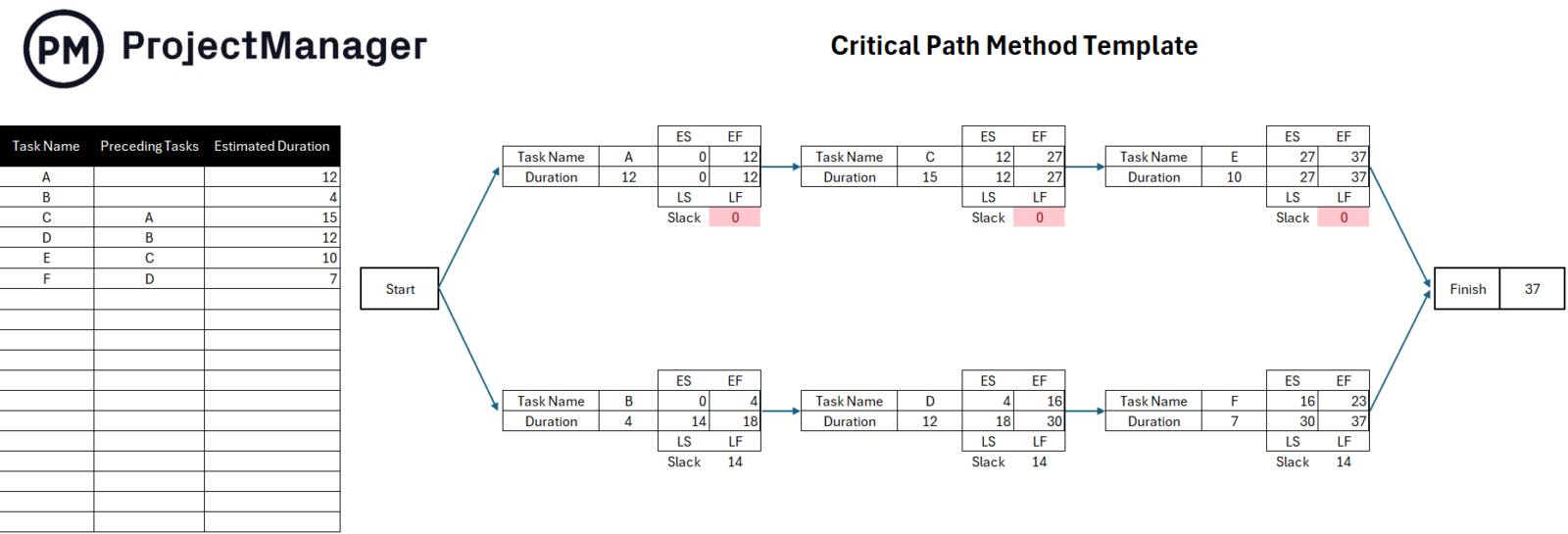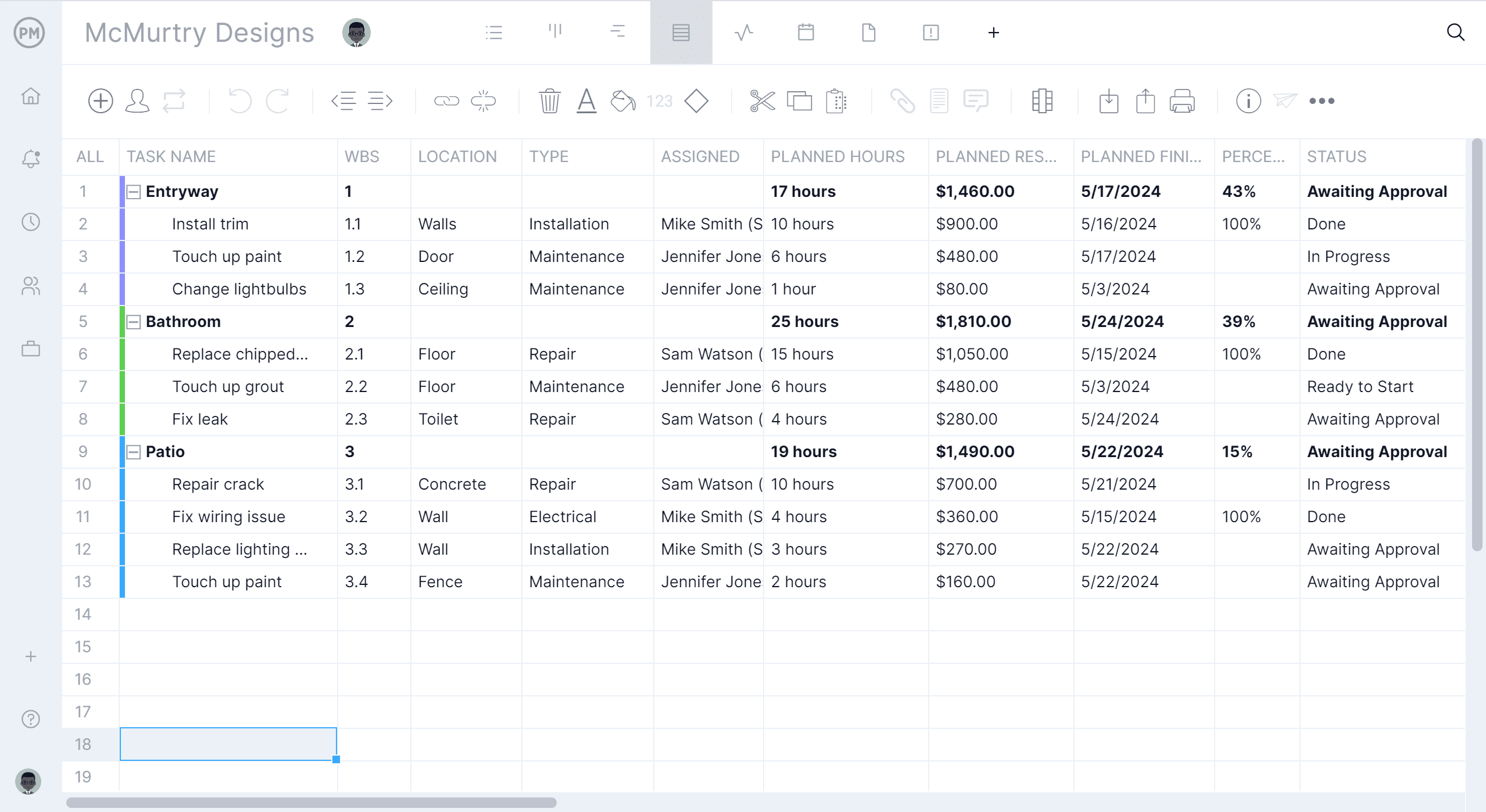Seasoned project managers know to use the critical path when planning and scheduling projects. Critical path analysis allows project managers to identify the tasks that must be completed to successfully deliver the project and, in so doing, define the project length. Critical path, therefore, is an essential project management technique for creating efficient schedules that complete projects on time and within budget.
Download this free critical path template for Excel to calculate the critical path of any project. Better yet, open the critical path template in ProjectManager and schedule the project on powerful Gantt charts that filter for the critical path. When you open the template, simply click the filter icon and select, “critical path tasks.” Besides a robust Gantt chart, there are multiple project views, including the sheet, kanban, task and calendar views, which all update simultaneously in real time.
Using the critical path template in ProjectManager also connects the project plan to essential project management features, such as live dashboards, resource management tools, customizable reports and more. All this on a collaborative platform with unlimited file storage, secure timesheets and all the tools project managers and their teams need to deliver successful projects. Get started with ProjectManager today for free.

What Is a Critical Path Template?
A critical path template is an Excel document that has a network diagram, which shows the tasks as nodes or boxes. They’re connected by arrows that represent the dependencies between tasks. The arrows show the proper sequence of tasks and each task is assigned a duration.
Why Use a Critical Path Template?
A critical path template offers a more efficient way of calculating the critical path of a project. Critical path analysis involves many calculations, which are embedded as formulas in this critical path template for Excel. That saves time and reduces the effort, though it still pales compared to project management software.
A critical path method template is ideal for complicated project timelines because it allows project managers to visualize the longest, most important chain of tasks that must be completed to deliver the project successfully. This provides the project manager with insight into which tasks to prioritize and how much time will be needed to complete them.
Using the free project management critical path template helps to improve accuracy and flexibility when scheduling projects. It also provides clear communication between the project manager and stakeholders, which is why it’s a staple of project planning and scheduling.

When to Use This Critical Path Method Template
Use the critical path method template at the beginning of the planning stage of any project. When coming up with a project schedule, the project management critical path template will inform the creation of the schedule. In fact, a critical path analysis template is so important to project planning that it’s often employed during the project proposal stage before the project has been approved.
That’s because understanding the critical path is key to creating a realistic schedule and delivering the project on time and within budget. It’s never too early to have a clear picture of what must be done, the resources needed to do it and the costs that are associated with the execution of the project tasks. Having this knowledge even before the project is approved helps determine whether the project is viable.
Not all projects are the same and not all projects get the same benefits from the critical path template. Therefore, the project management critical path template is ideal for more complicated projects such as those with large number of tasks, many of which are interdependent.
Who Should Use This Critical Path Analysis Template?
The critical path template is useful for many industries. There are those who use a project management critical path template in enterprises that have complex projects. Therefore, professionals in product development, defense contractors, general contractors in construction and those in the aerospace sector will all use a critical path analysis template.
The project professionals who will find the critical path template most useful are in charge of the project. These tend to be project managers, who are responsible for the planning, execution and control of projects to ensure that they’re not overspending or facing delays that can interfere with meeting deadlines.
For example, Apple uses the critical path method to deliver its new products to market on time. They map the steps that need to be completed and track the progress to ensure they’re staying on schedule.
What Does This Critical Path Template for Excel Include?
This critical path method template helps estimate the task duration to make an accurate project schedule and identify its critical path. But before getting into that, let’s start with some important definitions to be familiar with.
- Earliest Start (ES): It’s the soonest a task can start. There are two ways to determine the ES of a task. One, if a task has no predecessors, like tasks A and B in this sample CPM diagram, then their ES will be 0 as they don’t need to wait for another task to be completed for them to start, and two, if a task has any preceding tasks, then its ES will be the earliest finish EF of the preceding task.
- Earliest Finish (EF): The earliest a task can be completed based on its earliest start value and its duration. For example, task A ES is 0 and it’s estimated to take 12 weeks, so its EF is 12.
- Latest Start (LS): This is the last minute you can start a task before it threatens to delay your project timeline. It’s calculated during the backward pass process in the CPM scheduling process.
- Latest Finish (LF): The latest activity can be completed which can be calculated by adding its duration and ES values.
- Slack: This describes how long you can delay a task before it impacts its task sequence and the project schedule. The tasks on the critical path have zero slack because they can’t be delayed.
How to Use ProjectManager’s Critical Path Template for Excel
ProjectManager can instantly filter a project schedule on the Gantt chart to show the project’s critical path. There’s no need to go through complex calculations or use a critical path template. But for those who want to use the project management critical path template in Excel, follow these steps.
1. Forward Pass in CPM
Use the CPM diagram and the estimated duration of each activity to determine their earliest start (ES) and earliest finish (EF). The ES of an activity is equal to the EF of its predecessor, and its EF is determined by the CPM formula EF = ES + t (t is the activity duration). The EF of the last activity identifies the expected time required to complete the entire project.
2. Backward Pass in CPM
Begins by assigning the last activity’s earliest finish as its latest finish. Then the CPM formula to find the LS is LS = LF – t (t is the activity duration). For the previous activities, the LF is the smallest of the start times for the activity that immediately follows.
ProjectManager Helps Manage Project Schedules
The free critical path method template for Excel is a helpful tool but has limitations. For one, it’s isolated from the actual project schedule. Therefore, all that work has to be transferred to a project plan. The critical path template also has no link to all the other project management tools needed to deliver that project. ProjectManager is award-winning project and portfolio management software that can filter for the critical path and has a full suite of features to help with scheduling, resources and tracking costs.
Multiple Project Scheduling Views
Scheduling on the Gantt chart allows project managers to organize tasks, resources and costs and filter for the critical path. They can then set a baseline to track the planned vs. actual effort of their team to make sure they’re staying on schedule. However, Gantt charts aren’t ideal for team members executing their tasks, which is why there are multiple project tools so everyone can work how they want. Kanban boards visualize, customize and even can automate workflow, track costs and can be used for resource scheduling. Task lists are more than to-do lists, while the sheet view is a Gantt without a timeline and the calendar provides a monthly overview for stakeholders.

Manage Resources and Track Project Costs
The critical path method helps to create the project schedule, but to stay on track project managers must control resources. Once the team is onboarded to the project, each team member’s availability can be set, including PTO, vacation and global holidays, which makes assigning easier. To ensure that no one is overallocated, which can lead to delays, use the color-coded workload chart or team page to get an overview of the team’s workload and balance it to keep everyone working at capacity. Secure timesheets can provide visibility into labor costs or get a high-level overview of costs, time and more with real-time dashboards or customizable reports.

More Free Project Scheduling Templates
Not ready to upgrade to project management software? There are over 100 project management templates for Excel and Word that are free to download. These templates cover many industries and all project phases. Below are some of the free templates available for project scheduling.
Gantt Chart Template
While this free Gantt chart template doesn’t filter for the critical path, it can help project managers organize their tasks. On the left is a spreadsheet that captures all project tasks and their start and end dates. Once added, they automatically populate a project timeline to show the entire project from start to finish in one place.
Project Calendar Template
There are free templates for various scheduling views, such as the free project calendar template for Excel. The project calendar template is a planning tool that shows start and end dates for all project activities every month. The template has a year’s worth of pages to organize tasks and assignments.
Resource Plan Template
Keeping to a project schedule requires managing resources. Use this free resource plan template for Excel to identify, list and organize all the resources needed to execute and deliver a project. It also helps project managers determine how many resources they need to complete the project on time.
Related Critical Path Method Content
The critical path is too important a topic in project management to be fully covered in one place. For those interested in going further into the subject, our site is rich with resources. We publish blogs weekly, have tutorial videos and, of course, free templates. The following are some of the pieces that we’ve published on critical path.
- 12 Best Project Management Charts for Project Planning
- PERT and CPM: Their Differences and How to Use Them
- Displaying the Critical Path on a Gantt Chart
- How to make a CPM Schedule: CPM Scheduling Basics
- Plantilla de Ruta Crítica de Proyecto para Excel (Descarga Gratis)
- Modèle de chemin critique de projet pour Excel
- Kritischer-Pfad-Vorlage für Excel
ProjectManager is online project and portfolio management software that connects teams whether they’re in the office, out in the field or anywhere in between. They can share files, comment at the task level and stay updated with email and in-app notifications. Join teams at Avis, Nestle and Siemens who use our software to deliver successful projects. Get started with ProjectManager today for free.
